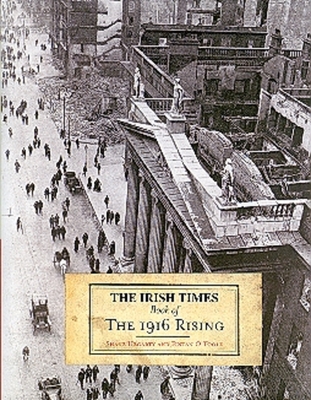Irish Times Book of the 1916 Rising
Declan O'Brien reviews The Irish Times Book of the 1916 Rising by Shane Hegarty and Fintan O'Toole, Gill and Macmillan, ISBN 0-7171-4191-8, €24.99 hbk

PUBLISHED IN 2006 to coincide with the 90th anniversary of the Easter Rising of 1916, Irish Times staff journalists Hegarty and O'Toole have combined with whoever did the design to produce an attractive, well-illustrated and eminently readable account of this key event in modern Irish history.
However, while the inclusion of eye-witness accounts by those involved on both sides of the conflict, and an emphasis on the 'human drama' of the Rising, undoubtedly help to make the book 'accessible' to the general reader, it falls well short of living up to the publisher's claim of being 'the most comprehensive' account of Easter Week in print.
Whatever quibbles one may have with the author's treatment of the Rising, Charles Townsend's Easter 1916: the Irish rebellion (2006), 1916 The Easter Rising by Tim Pat Coogan (Orion Books 2005), Max Caulfield's The Easter Rebellion (reprinted by Roberts Reinhart in 1995) or The Easter Rising by Michael Foy and Brian Barton (Sutton Publishing, 1999) remain stronger contenders for that particular accolade - though I suspect that the definitive account has still to be written.
This is not to undervalue the efforts of Hegarty and O'Toole, just to warn they are not, as is so often the case, commensurate with the publishers' claims.
However, excellent presentation and readability aside, this reviewer has a number of major quibbles with the book. Although the eyewitness accounts and attractive design, which includes many fine photographs, are very appealing, the basic historical narrative adds very little, if anything, to previous accounts.
The authors also fall into the trap of regurgitating certain politically-generated myths used by anti-national historians in more recent times to undermine the endeavours of the rebels. There's also no serious analysis of the overall historical and political context of the Rising, to aid the reader to gain a deeper understanding of these momentous events, and, despite the use of the accounts of participants on both sides of the conflict and others who observed it, the authors have ignored material which challenges the establishment view in a number of key areas.
One major example of an 'inconvenient truth' not to have found it's way in to the text concerns the response of Dubliners following the collapse of the Rising. The inclusion of Irish Volunteer and IRB-man Robert Holland's account appears to confirm the establishment view of widespread hostility shown towards the rebels by the ordinary people of Dublin in the wake of the rebellion's failure. Stationed at the Jameson's distillery during the Rising, Holland recalls that the surrendered troops were "subjected to very ugly remarks and cat-calls from the poorer classes" as they were marched to Richmond Barracks.
While no serious historian would doubt that there was hostility from some quarters, there is considerable available evidence - including from British military sources - which reveals a far more complex picture than is presented here and, it has to be said, in many other accounts of the Rising. As the historian Peter Berresford Ellis has pointed out previously in the Irish Democrat, Canadian journalist Frederick Arthur Mackenzie's account of the Rising suggests that hostility was largely confined to loyalist areas of Dublin, such as Richmond, where the population were dependent upon the local barracks for their income. In other poor areas of Dublin, however, Mackenzie witnessed a very different reaction.
Given that this book started life as an Irish Times supplement, produced in conjunction with the Department of Education and Science, and is clearly aimed both at school and students and the general reader, an opportunity to dispel rather than perpetuate some of the misleading establishment myths surrounding the Rising has clearly been missed. That's the charitable interpretation.
Those of a more radical bent might wish to point out that Irish Times remains, and was at the time of the 1916 Rising, very much the voice of the establishment.
There's also no serious analysis of the overall historical and political context of the Rising, which might enable the reader to gain a deeper understanding of these momentous events, and despite the use of the accounts of participants on both sides of the conflict and others who observed it, the authors have ignored material which challenges the establishment view in a number of key areas.
Connolly Association, c/o RMT, Unity House, 39 Chalton Street, London, NW1 1JD
Copyright © Declan O'Brien 2007

